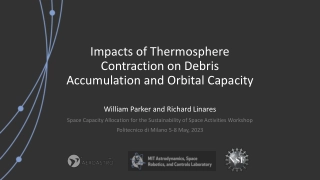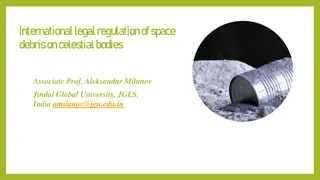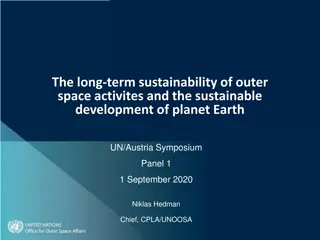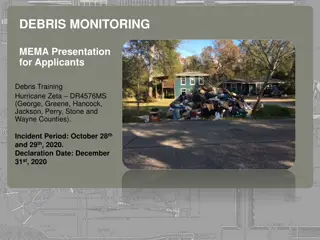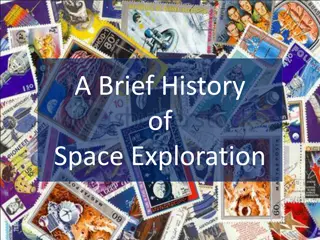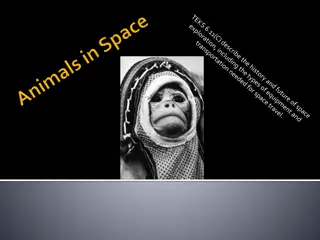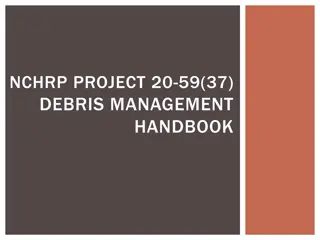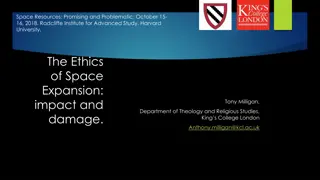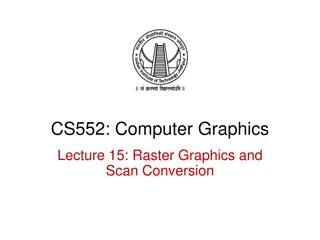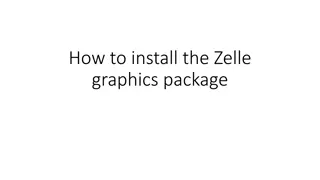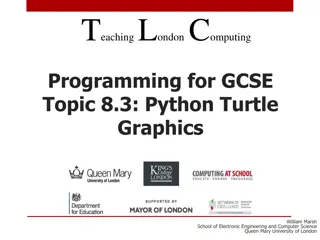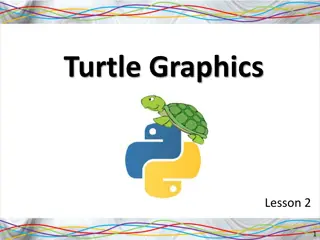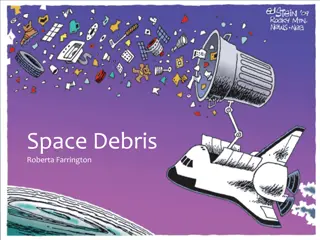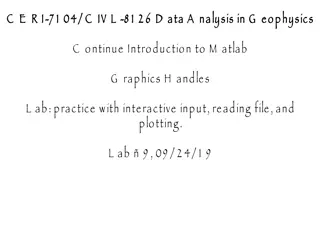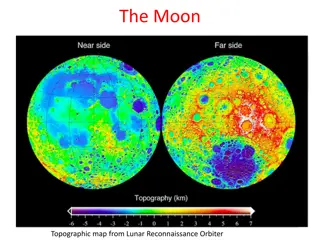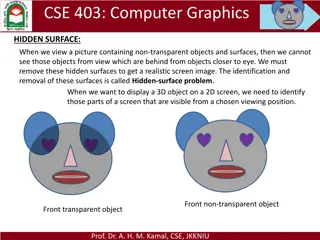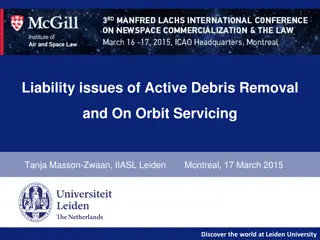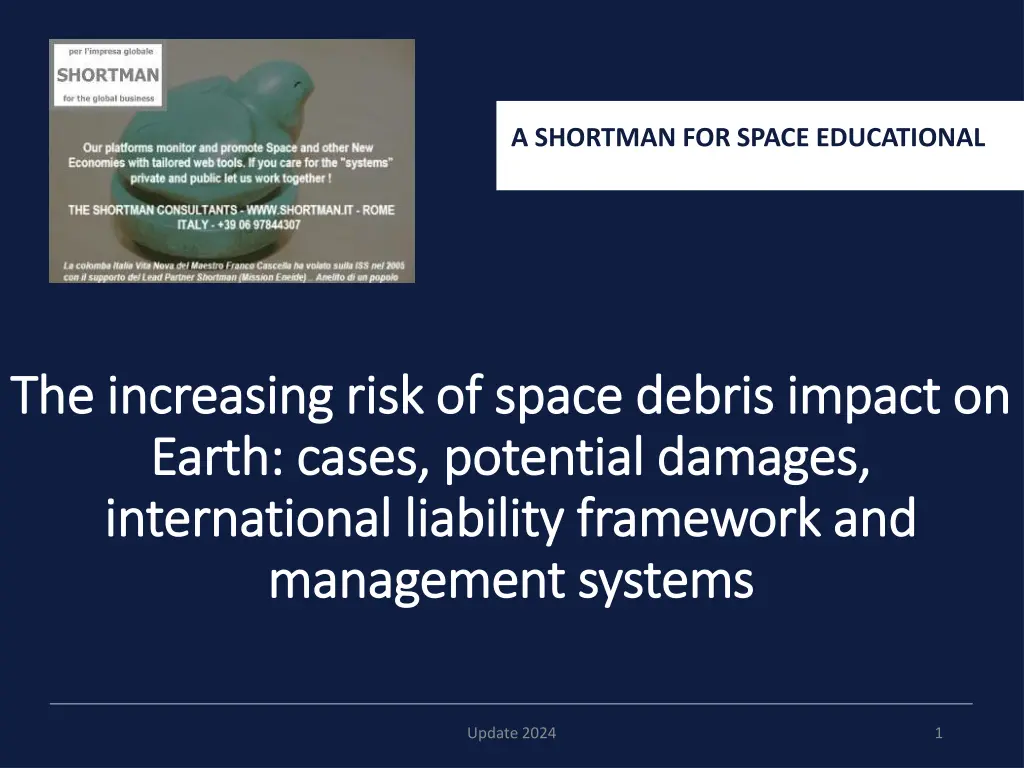
Understanding the Alarming Risk of Space Debris Impact on Earth
Delve into the escalating threat of space debris impact on Earth, highlighting potential damages, international liability, and management systems. Explore the concerning rise of space objects in orbit and the challenges they pose to human population and infrastructure.
Uploaded on | 1 Views
Download Presentation

Please find below an Image/Link to download the presentation.
The content on the website is provided AS IS for your information and personal use only. It may not be sold, licensed, or shared on other websites without obtaining consent from the author. If you encounter any issues during the download, it is possible that the publisher has removed the file from their server.
You are allowed to download the files provided on this website for personal or commercial use, subject to the condition that they are used lawfully. All files are the property of their respective owners.
The content on the website is provided AS IS for your information and personal use only. It may not be sold, licensed, or shared on other websites without obtaining consent from the author.
E N D
Presentation Transcript
A S A SHORTMAN FOR SPACE EDUCATIONAL The increasing risk of space debris impact on The increasing risk of space debris impact on Earth: cases, potential damages, Earth: cases, potential damages, international liability international liability framework and management systems management systems framework and Update 2024 1
Space Space debris debris impact on Earth impact on Earth a a definition definition These contents are a summary of congress proceedings and courses we held in the years 2017-20 for the Rome 2 University Tor Vergata University annual II degree International Master Course Protection against CBRNe events (Cyber, Bio, Radiation, Nuke, explosive ..) , integrated and updated from alike contributions on the Space debris impact theme we presented at IAC Conferences (Space Economy and Society Symposia) in Adelaide (2017) and Baku (2023). The investigated domain is (as by the IADC InterAgency Space Debris Committee within the UN COPUOS section definition): all human made objects (no asteroids therefore which fall in the Acts of God domain) including fragments and elements thereof, in Earth orbit or re-entering the atmosphere, that are non functional . The focus is on the actual or potential damages deriving from their impacts on human population and mobile or steady infrastructures, general assets, with the exception of launch areas which are by definition risk safe . In fact, from the beginning of human space activities, and especially in these last years, the number of space objects in orbit around the Earth is alarmingly and exponentially increasing and the trend is up (new small satellites, Kessler syndrome, etc.). NASA ESA estimates tell us we currently have hundreds of millions objects orbiting between LEO (up to 10.000km) and GEO (above that altitude at ca. 50.000 km) levels weighing >5000 tons This figure ranges from submillimetric items (propellant dust, paint flakes, etc.) to baseball sizes and above (the latter more than 100.000) 2 2 24 May 2017 Session 9 Bergamini Elisabetta, Jacobone Francesca, Morea Donato, Sciortino Giacomo Primo Update 2024 2
Space Space debris debris impact on Earth impact on Earth a a definition definition A NASA radar image of trackable space orbiting items shows us that 95% is debris. 60% is concentrated in LEO orbits and congestion is higher over the poles. Harmful items of smaller size (between 1 and 10 cm) remain untrackable 2 2 24 May 2017 Session 9 Bergamini Elisabetta, Jacobone Francesca, Morea Donato, Sciortino Giacomo Primo Update 2024 3
Space Space debris debris impact on Earth impact on Earth a a definition definition Update 2024 4
Space Space debris debris impact on Earth impact on Earth a a growing growingthreat threat The situation is alarming also considering the ever growing number of low orbit TLC and EO small satellites (SpaceX Starlink, Google Planet Lab, OneWeb, Huawei, etc.), space and suborbital tourism vehicles (Virgin Galactic, Blue Origin, etc.), cargo services to manned orbiting stations* and also other vehicles (sounding rockets, baloons and UAVs) that crowd Space from its commonly perceived low boundary that is the end of stratosphere (30-40km altitude) ** - in the LEO range. What is most dreaded is the so called Kessler effect, that is the massive exponential self-propagation of debris ensueing collisions in Space. Collisions, in fact, by far more than breakups, generate debris (for instance note that in the previous graph on the size of a baseball and up objects only 10 collisions are involved, compared to 250 breakups). As an example, consider that the chinese Feng Yun 1c anti satellite test in 2007 only created 3300 pieces of sizeable debris, and in february 2009 2200 more fragments were created by the crash of Iridium33 and Kosmos2251 satellites Consider also that at an average speed of 30.000km/h in LEO orbit even 1cm large (there are approx. 700.000 of them) items can destroy a satellite ! Slightly below a small splinter can pierce a plane s cockpit ! * In view of future Moon and Mars human missions (i.e. heavy/200 tons payload reusable 2 stage SpaceX Starship) some will be O gravity points at 5000km altitude permanentrefuelimg stations to facilitate interplanetarytransportation ** This reference instead of the Karman line 100km from Erth surface is lately most commonly considered the border of Space because most of its characteristics are already present even if not completely, and have a strong influence on operations (radiation, color of sky, temperature and pressure etc,). Update 2024 5
Space Space debris debris impact on Earth impact on Earth a a growing growing threat threat Although the 75% of objects launched in space is re-entered into the atmosphere in a controlled way and the atmosphere itself is a natural firewall that destroys the uncontrolled re-entering objects, the risk of impacts on Earth is clearly surging and persons, land and properties Elaborating NASA-NORAD s data with the exponential trend above we can estimate that the rate of 1 reported impact a day in 2007 (>10 cm of size a baseball) is now almost 10 times more, and including larger items becoming perceivable on 5 5 24 May 2017 Session 9 Bergamini Elisabetta, Jacobone Francesca, Morea Donato, Sciortino Giacomo Primo Update 2024 6
Space Space debris In the following tables we have collected some of the most notable cases of space debris impact onto Earth, in the past. No sizeable damage to property reported. Only environmental and minor injuries to people (Japanese sailors in 1969 and Oklahoma woman in 1997). debris impact on Earth impact on Earth notable notableexamples examples 11 november 2016 at a Jade Mine in Hpakank (North Myanmar) a booster of the Long March11 chinese launcher slams onto Earth with a blast and one small piece pierces the metal roof of a nearby shack. On 9 november the launcher departedfrom Jiuqing space base (1600 km away to the North) carrying an experimental satellite (The Sun UK 2016) Update 2024 7
Space Space debris debris impact on Earth impact on Earth notable notableexamples examples Date and place of impact Identified objects Damages Liability and insurance aspects 1978 Northern Canada One nuclear powered ocean surveillance russian satellite Cosmos954 Actual coolant release and risk of puncture and more release rated 8% over 50 years Russian Government liable pays 3M settlement to Canada Gvment 1979 South of Perth in Australia / error due to quick burning Space litter with large pieces of the deorbited US Skylab Minor environmental damage (it was due to crash in S.Africa) US Government rescue fallen parts and pay Shire fine of $400 1991 Argentina / route error by several 1000km Deorbiting Russian Salyut7 manned 40tons Space littering of wide area in Argentina Russia not known April 2000 Township outside Cape Town (S.Africa) 3 large pieces of USAIR Delta II launcher rockets for GPS sat Minor damages to caused by white hot large objects USA not known but likely settlement for private owners June 2000 Pacific Ocean US Gamma Ray Observatory 1500 debris spray after controlled crash USA - No Update 2024 8
Space Space debris Date and place of impact debrisimpact on Earth impact on Earth notable Identified objects notableexamples examples Damages Liability and insurance aspects Jan 2001 Saudi Arabia desert (Rhiyad) Engine assist and GPS satellite large parts + part of Delta II launcher None USA - none March 2001 in dead sea zone South Pacific 2500km East of NZ MIR 130tons russian human laboratory deorbiting and controlled sea crash No Russia subscribed insurance policy before deorbiting up to 200M settlement for damage/casualties 2003 Texas and Louisiana (USA) Over 2000 debris items of Columbia shuttle destroyed during reentry from Hubble mission One of single large space debris incident in history USA - None Sept 2004 Utah desert (USA) Genesis USA spacecraft solar mission capsule Parachute failed to deploy no damages USA NASA - None 2007 Western Australia Russian Breeze booster explodes while orbiting Arabsat satellite More than 1000 debris scattered Russia not known if settlement paid Update 2024 9
Space Space debris Date and place of impact debris impact on Earth impact on Earth notable Identified objects notableexamples examples Damages Liability and insurance aspects Nov 2015 Spain Unlisted parts of spy satellites fuel tanks No Undefined Nov 2015 Sri Lanka (Indian Ocean) WT1190F classified objetcs coming from Moon orbit (maybe Apollo) No destroyed by atmosphere. Intercepted and tracked via algorithms No mitigation technique carried out by dedicated aircraft USA, Germany, Emirates crew Jan 2016 - Vietnam Metallic spheres of air tanks of russian Zenith launcher None, landed by a river in the countryside Russia Nov 2016 - Myanmar Long March11 (PRC) booster and litter thereby Crashes into jade mine field Not acknowledged yet Update 2024 10
Space Space debris In the last years these episodes have intensified strongly. Among the most notable various events there are in the years 2022-24 the fall of undestroyed re-entry expendable boosters of the SpaceX Dragon system in Australia, causing little damages to properties (see the picture below). In may 2024 the same Dragon debris (40kg) hit a North Carolina resort; in march 2024 it was the case of a house in Florida being hit by an ISS fragment. Only damages to properties again. debris impact on Earth impact on Earth notable notableexamples examples Update 2024 11
Space Space debris The international Outer Space Treaty (1957) prohibits mass destruction weapons but not conventional, declares mankind property of space resources, and defines responsibilites of Governments (Art. 7 on Responsibilities and following Liability Convention of 1972) for third party damages resulting from space activities (related to their own assets or caused to other s) The Treaty is signed by 105 States but only few detain an open archive and monitoring of their flying objects or debris, so that sometimes these cannot be identified Insurance is available so far, therefore, only for Governments and on a syndicated tailor made basis. See the example of Russia for the MIR re-entry programme. Lloyds and Allianz have experiences debris impact on Earth impact on Earth legal legaland and insurance insuranceframework framework Update 2024 12
Space Space debris debrisimpact on Earth impact on Earth legal legaland insurance framework and insurance framework Unlike other near-Space activities, like for instance the launch and operation of TLC commercial satellite constellations, for which full fledged insurance frameworks are available for public and private clients at market prices (the worldwide business turnover for Companies is currently valued around 1bn ), the cover of space debris third party liability is shy of becoming available, as we said before, except for Governments, and in limited syndicated cases This is due to the a still immature Risk mitigation system in this domain which hampers the formation of a solid premium/damage balance forecast for the insurance investors. The main pillars of one such systems could be summarised as follows: - Mandatory enforced SST Space Surveillance and Tracking/SSA procedures for continuous tracking of flying vehicles and especially a strictly controlled and targeted demise at end of life - Enforced construction standards of vehicles aimed at decreasing the risk of maneuvering failures (i.e. by subsystems redundancy) or non destruction at atmospherical re-entry (i.e. by using suitable materials) - Periodical institutional Debris cleaning campaigns carried out by the Space fairing Governments It is likely that if and when these context conditions are fullfilled some insurance services will appear on the market especially in large scale activities such as the small satellites for TLC and EO or the future passenger suborbital long distance flights. Some expansions on each of these aspects are in the three next slides Update 2024 13
Space Space debris Surveillance Surveillanceand Tracking systems and Tracking systems debris impact on Earth impact on Earth Mandatory Mandatory enforced enforcedSST SST Space Space NASA (and DoD) issued in 1995 the Debris Mitigation Standard Practices that require mandatory controlled deorbiting of space vehicles at the end of useful operations. Likewise, UN COPUOS adopted similar IADC Inter Agency Debris Committee Guidelines for voluntary subscription of member States (last approved version is dated 2007, so far only USA, Russia, Europe, Japan and UK have undersigned for law enforcement). Several other regulations are in the Guidelines, apart from on controlled demise, such as the prohibition of intentional destruction (see the China devastating anti satellite test in 2007). A cleaning tax - as a fee to pay for each orbital launch licence - is a probable solution under study to ensure Governments the funding to buy insurance coverage for their national Space operators conduct, leaving the legal framework unchanged, and therefore their main nominal responsibility for space debris damages. Update 2024 14
Space Space debris Surveillance Surveillance and Tracking system s and Tracking system s debrisimpact on Earth impact on Earth Mandatory Mandatory enforced enforcedSST SST Space Space Technically speaking the controlled deorbiting of space vehicles is only one of the domains of dedicated national institutions which use multiple devices (optical sensor, radars, radiotelescopes) and when possible integrate their actions, especially near the presumed final impact area, with GNSS localisation and on site missions (land, sea and air). These institutions (in Italy AM): - Operate in international coordination. Italy in particular in the EU SST Network which in turn is a component of the wider SSA (EU Space Situational Awareness Network) which enlarges its activities to asteroid and Space weather monitoring - The introduction of standardized sensors (i.e. the so called sCMOS) on the vehicle bodies autolocalisation could soon become mandatory within this context or GNSS devices for Update 2024 15
Space Space debris of of vehicles vehicles debrisimpact on Earth impact on Earth Enforced Enforced construction constructionstandards standards The main manufacturing solutions, in turn forming one chapter of the IADC Guidelines, to mitigate the space debris impact risk on Space vehicles are: Special materials to facilitate atmospherical re-entry Stronger space vehicle structures designed to resist small size debris impacts (<1cm) Whipple shields (like those on ISS) that disintegrate debris Impact sensing and dodge maneuvering systems (CAM) Finally we mention the increasing number of Space Cleaning campaigns performed by dedicated satellites (see the NASA periodical missions) equipped with capture nets, destructive lasers, rescue arms and stowage bays (considering the high value of rescued scrap for in space reparations and refuelling imagine that a case of 1000 tons of alluminium would otherwise cost 10 billion in launching cost) complete self destruction at Update 2024 16
Hourra, avec lassurance on aura plus peur que le ciel nous tombe sur la t te !!! AU REVOIR Update 2024 17

